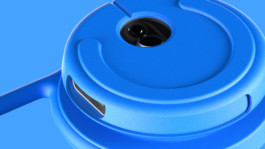
Client: Ottobock SE & Co. KGaA
Year: 2018
Sector: Medical technology
Service: User research, Design Analysis, UI & UX Design, Product Design
Hand amputees are hindered in their use of digital hardware: mouse, keyboard and touchscreen require fine movements, which current prostheses do not deliver. This became very clear when we accompanied amputees in their everyday lives. The leading paradigm in the prosthetics industry is to mimic organic hands. But technology is far from fulfilling that. Our outsider perspective allowed us to think outside the box and develop a new paradigm.
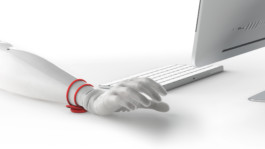
Based on the findings of the user research, we designed a wearable add-on that digitally connects to myoelectric prostheses and enables intuitive interaction with computers.
Currently, a command has to travel a long way: From muscle signal to motors to keys to computer. Shortcut bypasses all of that: It directly connects prosthesis and computer and triggers digital outputs in an instant.
The wearable translates muscle signals into clicks, scrolls and other controls. Arm movements are translated into cursor motion. The similarity to mouse principles minimises learning effort.
Left click
Right click
Drag and drop
Scroll
Switch
Rotate
Zoom
Quit
We designed an extended gesture catalogue, working towards the vision of ‹reaching into the computer›. The industry is going to implement products with more muscle sensors shortly, which will allow Shortcut to reach its full potential of comprehensive controls.
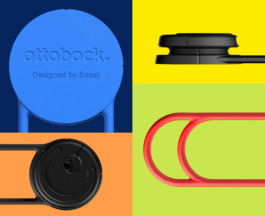

Shortcut’s look and feel consciously breaks with conventional medical aesthetics, as we found that users often find these particularly stigmatising. A new design language promises increased rates of usage.
PROCESS
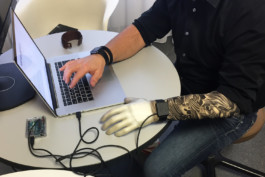
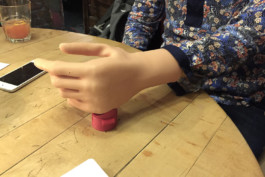
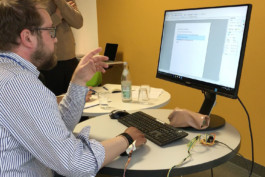
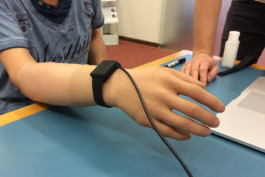
An experience cannot be designed in theory, you have to make it tangible. With consecutive working prototypes and with the help of users we were able to validate the concept and refine the interaction principles step by step.
MORE PROJECTS
CONCEPTION
ELABORATION
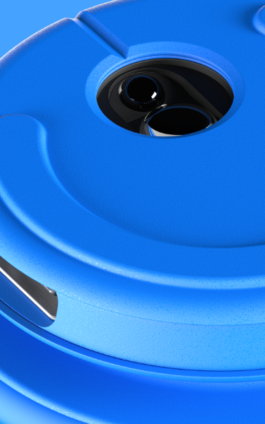
Client: Ottobock SE & Co. KGaA
Year: 2018
Sector: Medical technology
Service: User research, Design Analysis, UI & UX Design, Product Design
Hand amputees are hindered in their use of digital hardware: mouse, keyboard and touchscreen require fine movements, which current prostheses do not deliver. This became very clear when we accompanied amputees in their everyday lives. The leading paradigm in the prosthetics industry is to mimic organic hands. But technology is far from fulfilling that. Our outsider perspective allowed us to think outside the box and develop a new paradigm.

Based on the findings of the user research, we designed a wearable add-on that digitally connects to myoelectric prostheses and enables intuitive interaction with computers.
Currently, a command has to travel a long way: From muscle signal to motors to keys to computer. Shortcut bypasses all of that: It directly connects prosthesis and computer and triggers digital outputs in an instant.
The wearable translates muscle signals into clicks, scrolls and other controls. Arm movements are translated into cursor motion. The similarity to mouse principles minimises learning effort.
Left click
Right click
Drag and drop
Scroll
Switch
Rotate
Zoom
Quit
We designed an extended gesture catalogue, working towards the vision of ‹reaching into the computer›. The industry is going to implement products with more muscle sensors shortly, which will allow Shortcut to reach its full potential of comprehensive controls.
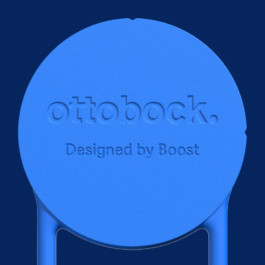
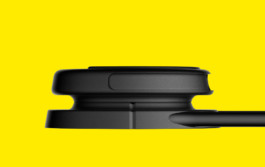
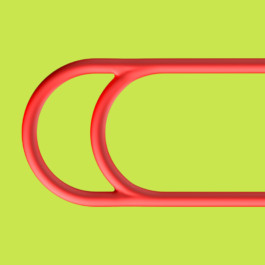
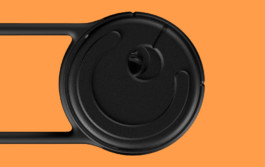

Shortcut’s look and feel consciously breaks with conventional medical aesthetics, as we found that users often find these particularly stigmatising. A new design language promises increased rates of usage.
PROCESS




An experience cannot be designed in theory, you have to make it tangible. With consecutive working prototypes and with the help of users we were able to validate the concept and refine the interaction principles step by step.
MORE PROJECTS
RESEARCH
ELABORATION
Boost GbR
Kurfürstenstraße 143
10785 Berlin, Germany
Legal notice
©2024 Maximilian Mahal
David Kaltenbach
Boost GbR
Kurfürstenstraße 143
10785 Berlin, Germany
© 2024, Maximilian Mahal,
David Kaltenbach